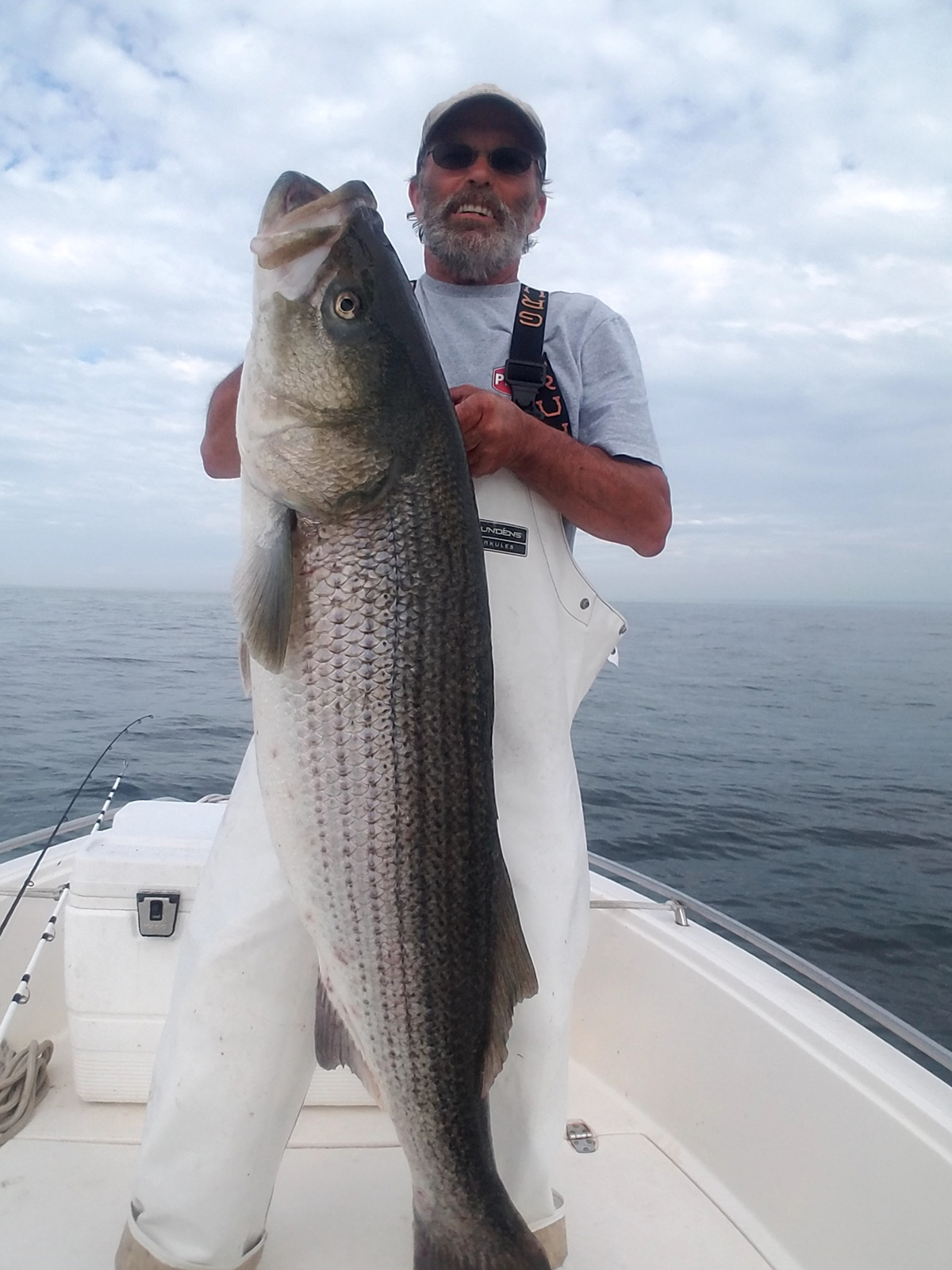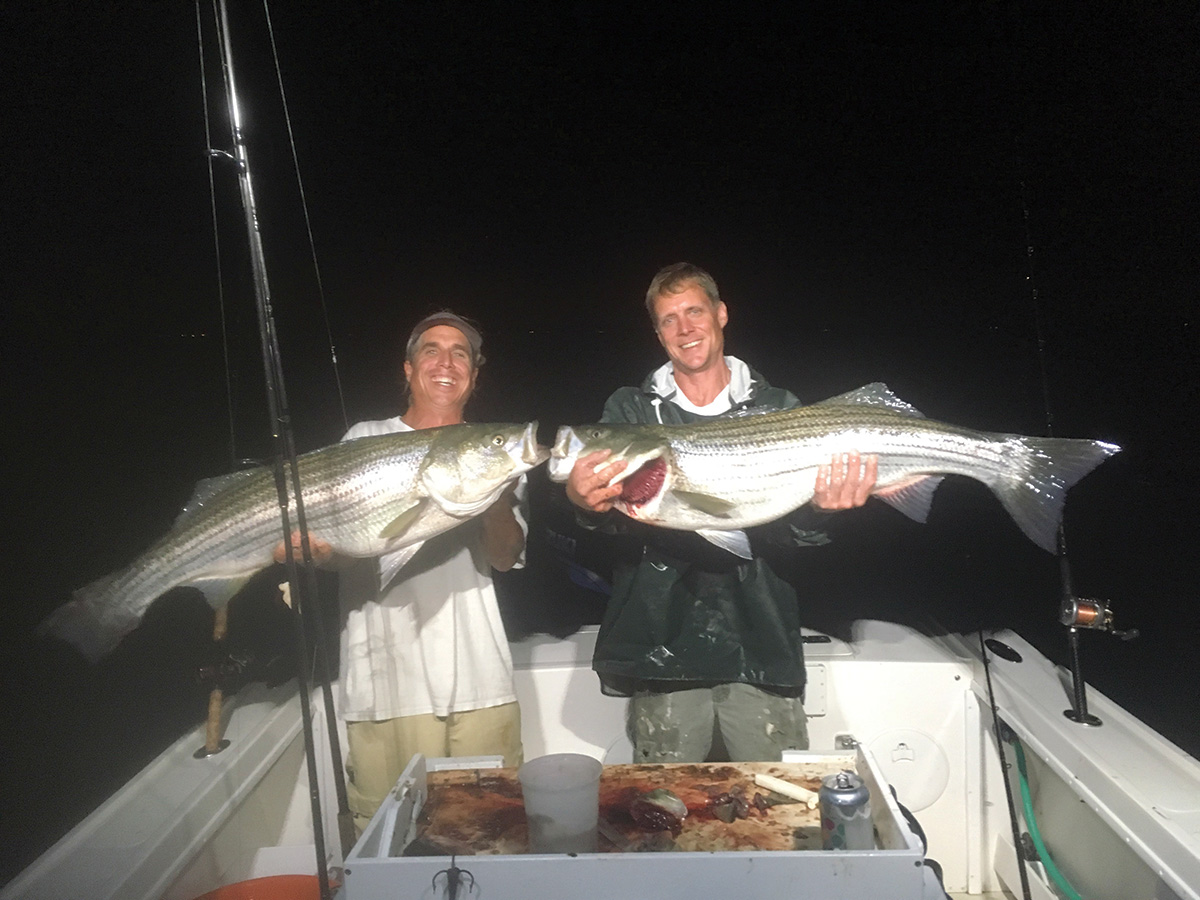
During the dog days of summer when the water heats up to 70 degrees or so it seems that most gamefish head for deeper climes. That is to say they move off into deep, cool water where they feel more comfortable. I’m talking about water that is over 70 feet deep with 80 to 100 feet the target range. Not many anglers think to fish these depths for bass and blues, but I’ve learned to send chunks down deep where the fish are to find dog day bass and blues.
My first experience with deep water chunking was over 20 years ago with my buddy Doug Brodsky of Blue Frog Bucktails. When summer was in full swing, and the fluke fishing slowed down we fished at night when we thought the bass and blues would finally come onto the shallow reefs and rock piles. We found some success but not the numbers we were looking for. We heard from a friend of Doug’s that we should try sending chunks down to the bottom in 80 to 110 feet of water during the middle of the day. We both looked at each other like the guy had two heads. He kept at us to do what he said.
Cool and Deep
We’re not the type to sit idly by and not give things a go so we decided to heed the advice of our mentor and give it a whirl. We loaded up with 10 pieces of the freshest bunker we could get our hands on and headed out for the deep water of Long Island Sound. We got out to 80 feet of water due north of Mt. Sinai Harbor and dropped anchor just before high noon. It took a few minutes for us to get enough scope for our anchor to find a solid bite in the hard running current. Once that was done, we set up our rods and started to pin chunks to the bottom. Several minutes later we had our first run off from a teen-size bluefish, and the bite was on! We went through all of the bunker we had in only a couple of hours and had sore arms to boot. We landed over two dozen fish between us including several nice bass up to 22 pounds. Keep in mind this was the end of July, and the sun was shining bright, and the temps were in the high 80s. It was hot out there to say the least. The fish didn’t seem to care one bit though.
The deep water with its cooler temperatures seems to be the key to stripers setting up in these depths during summer’s heat, and very often you will find success on open bottom with little or no structure evident. However, with stripers being such a structure oriented species, finding some form of structure leads to more consistent success. Study your charts and do some exploratory runs with your eyes glued to your fishfinder. Look for ledges or drop-offs, clusters of boulders or wrecks, no matter how large or small. Once you have done the legwork, you can return to these numbers time after time.

Gearing Up
Let’s talk tackle. The rods we use for this type of fishing are pretty heavy. I suggest a 7-foot medium to medium-heavy rod with a line rating of 17 to 30 pounds. The rod needs to be capable of handling lead up to 12 ounces so it needs some backbone. When we first started this type of fishing we used 30-pound monofilament line, so we needed some good size sinkers to keep our baits on the bottom. Nowadays we use braided line and get away with sinkers as low as 6 ounces in 80 feet of water, but don’t think you won’t need to step up to that 12-ounce sinker when the current gets ripping hard in 100 feet of water even with braided line.
The rigs we use are very simple, and there are two choices. You can either use a fish-finder rig or a three-way rig; the choice is yours. I stick to a fish-finder rig with the sinker slide although I have used a three-way set up with just as much success. Make sure you use a braid-friendly sinker slide on your fish-finder rig if you’re using braid on your reel. The braid cuts right through a plain nylon sinker slide, and lead is getting expensive. The leader I use is made up of 15 to 24 inches of 60-pound clear Surflon that is crimped on both ends. One end has the hook, and the other end has a size 2 Spro power swivel that ties directly to my running line. I tie my running line to the swivel with a palomar knot. I also add a plastic bead between the swivel and the sinker slide to protect the knot. I use hooks in sizes 7/0 to 9/0 on the business end. You can use any hook that will stand up to a good size bass or bluefish. I use a Mustad beak hook, model 92553SS, or a Gamakatsu #24 Octopus hook in the same sizes I mentioned above. All of these choices work well. Circle hooks are a good choice to help avoid deeply hooked fish intended for release. The three-way rig has one 12-inch length of mono tied to the swivel. This leader has a loop at the end to put the sinker on and is able to change the size of the sinker as the conditions warrant. The second eye has the same 15- to 24-inch leader made up of 60-pound Surflon leader crimped on with the hook crimped on the other end. The running line from your rod is tied onto the third eye using a palomar knot.
A whole bunker is chunked into three or four pieces including the head. I mince up the tail piece and throw it up current to start a chum slick going. We even sacrifice one or two whole bunker to mince up into little pieces and throw them up into the current to chum the fish to us. You won’t need to chum too heavily but some chumming does help to start the bite going. Once you start to get some bites or runoffs you can stop the chum line and just let the chunks do their jobs. We never tried using a chum pot on the bottom, but I wouldn’t recommend it. You’d have to use a gallon size pot on a heavy line to get it down to the bottom and have it stay there. It just seems like too much work to me, but to each his own. You need to keep the chunks fresh, which means you need to change them out after five minutes or so or the scent just gets washed out in the current. Washed out chunks don’t catch fish. The hook placement in the chunk is very important. I simply put the hook through the top of the back near the dorsal fin. Make sure the hook comes through the other side and doesn’t have any scales on the hook point, which can prevent the hook from setting into the fish’s jaw when it strikes.
You never know what you may catch when deep water chunking, and the potential for a quality bass is always there. Already this season there have been a number of big stripers taken on chunks in deep water. We had bass to 39 pounds and bluefish upwards of 15 pounds on Doug’s boat last season, as well as some brown (sandbar) sharks. These sharks are off limits and must be released. Use a long handled de-hooker or cut the leader as close to the mouth as you safely can to avoid bringing them aboard and ensure a healthy release.
While your buddies are complaining about the lack of stripers and big blues during the dog days of summer, gather up some fresh chunks, anchor up over some deep water structure, and get set to do battle with some quality stripers and blues.



